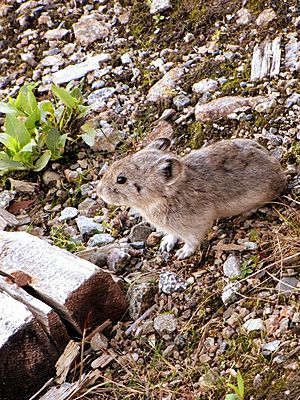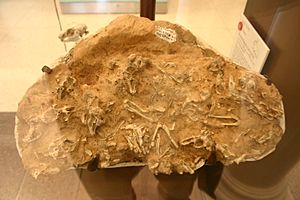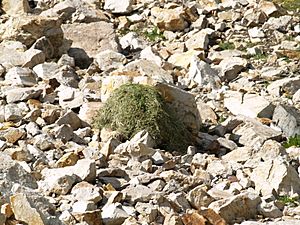Pika facts for kids
Quick facts for kids Pika |
|
|---|---|
 |
|
| American pika (Ochotona princeps) | |
| Scientific classification |
|
| Kingdom: | Animalia |
| Phylum: | Chordata |
| Class: | Mammalia |
| Order: | Lagomorpha |
| Family: | Ochotonidae Thomas, 1897 |
| Genus: | Ochotona Link, 1795 |
| Type species | |
| Ochotona daurica |
|
| Species | |
|
See text |
|
A pika ( PEYE-kə) is a small mammal. They live in mountains in Asia and North America. Pikas have short legs and a round body. They have soft fur and no outside tail. They look a lot like their relatives, the rabbits, but with short, round ears. Some pikas, like the large-eared pika, live very high up in the Himalayas. They can be found at more than 6,000 m (20,000 ft) high!
The name "pika" comes from a language called Tungus. The scientific name Ochotona comes from the Mongolian word ogotno. This word also means pika. Pikas belong to a group of animals called lagomorphs. This group also includes rabbits and hares. Pikas are the smallest animals in the lagomorph group. There are 37 different kinds, or species, of pikas alive today.
Pikas like to live on rocky slopes. They eat many different plants, like grasses, flowers, and young stems. In the fall, they gather hay, twigs, and other food. They store this food under rocks to eat during the cold winter. Pikas are also called "whistling hares." This is because they make a loud, high-pitched sound when they are scared. In North America, you can find two kinds: the American pika and the collared pika.
Contents
Where Pikas Live
Pikas live in cold places in Asia and North America. Most pikas live on rocky mountain sides. They find many small spaces in the rocks for shelter. Some pikas also dig simple burrows to live in. A few types of pikas live in open steppe lands. In the mountains of Eurasia, pikas sometimes share their burrows with snowfinches. The snowfinches build their nests there.
Because of changing temperatures, some pika groups have had to move. They now live only in even higher, colder places.
Pika Features
Pikas are small mammals. They have short legs and rounded ears. Their bodies are about 15 to 23 cm (5.9 to 9.1 in) long. They weigh between 120 and 350 g (4.2 and 12.3 oz). Their weight depends on the type of pika.
These animals are herbivores, meaning they only eat plants. They eat many kinds of plants. This includes flowers, grasses, and small branches. They also eat moss and lichens. Pikas have a special way to get all the nutrients from their food. They eat some of their own waste, called cecotropes. This helps them digest tough plant fibers.
Collared pikas have even been seen storing dead birds in their burrows. They might eat these birds during winter. They also sometimes eat the waste of other animals.
Like rabbits, pikas have strong front teeth for gnawing. They do not have pointy canine teeth. Their paws are covered with fur and do not have soft pads.
Pika Life Cycle
Pikas that live in rocks usually have small litters. They have fewer than five babies at a time. Pikas that dig burrows often have more babies. They also breed more often. This might be because there is more food where they live. Baby pikas are born helpless. Their eyes and ears are closed, and they have no fur. They are born after about 25 to 30 days.
Pika Activities
Pikas are active during the day or at twilight. Pikas that live in higher places are usually more active during the day. They are most active just before winter starts. Pikas do not hibernate (sleep through winter). They stay active all winter long. They travel through tunnels under rocks and snow. They eat the dried plants they stored earlier.
Rock-dwelling pikas gather plants in two ways. They either eat the plants right away. Or they collect plants to store in a "haypile." This pile of plants dries on the rocks. They then move it to their dens for winter.
Human activities can affect pikas. If pikas think humans are predators, they might spend less time looking for food. This means they store less food for winter. Pikas prefer to find food when it's cooler than 25 °C (77 °F). So, they often stay in shady spots when it's hot. If the temperature goes up by 1 °C (1.8 °F), pikas can lose 3% of their time to find food.
Pikas in Eurasia often live in family groups. They work together to find food and watch for danger. Some kinds of pikas protect their own areas. North American pikas, like the O. princeps and O. collaris, live alone. They only come together during breeding season.
Pika Sounds
Pikas make different kinds of sounds. Their calls can be short and quick, or longer songs. The short calls can sound different depending on where the pika lives. Pikas listen to sounds to know when to make their short calls. They use calls to recognize each other. They also use them to warn about predators or to protect their territory. Calls can also help them find a mate.
The calls change with the seasons. In spring, during breeding season, pikas sing more often. In late summer, their calls become shorter. Scientists can study these sounds. This helps them learn more about different pika species.
Pika Lifespan
Pikas usually live for about seven years in the wild. Scientists can tell a pika's age by looking at lines on its jawbone. Male and female pikas usually live for the same amount of time.
Images for kids
See also
 In Spanish: Picas para niños
In Spanish: Picas para niños






